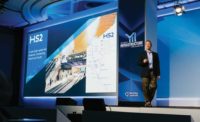As cities clamor for ways to improve transportation infrastructure and delivery of services such as power and water, digital models are being touted as a way for planners to try out different scenarios in the virtual world. Currently, these “digital twins” of their real-world counterparts are limited in scope, used to model specific transportation corridors or wastewater treatment plants. But what if there were an all-encompassing virtual platform that incorporates real-time data collected from major infrastructure systems within a real city, which then feeds back to help city agencies optimize those systems?
To answer that question and how such a platform could be structured and implemented, Georgia Tech, in partnership with several other universities and sponsored by the National Science Foundation, assembled smart-city experts in city governments, national laboratories, academia and the industry from around the U.S. to participate in the kick-off Smart City Digital Twin Convergence workshop at the school’s Atlanta campus last month.
“We have a lot of work to do to figure out the mechanics of how smart city digital twins can be used to understand, predict and optimize our interactions with infrastructure, but it is really important we do so, as they have the potential to meaningfully enhance the sustainability, resilience and livability of cities,” says John E. Taylor, the Frederick Law Olmsted professor of civil and environmental engineering at Georgia Tech, and one of the organizers of the think tank.
Presenters showcased digital-twinning technology now being utilized. For example, the city of Atlanta recently created the North Avenue Smart Corridor, which uses hundreds of sensors and high-definition cameras to feed real-time data into models to improve signal timing and reduce travel times and emissions. The city also is developing sensors that can differentiate pedestrians, cars and bikes and feed data into a digital twin to improve safety for all modes of transportation, says Lillie Madali, smart city program director for Atlanta.
Running simulations and experimenting in the virtual platform can help agencies “break the status quo” when trying to come up with new ways to optimize a city’s infrastructure or services, says Grace Simrall, chief of civic innovation and technology with the city of Louisville. It can “demonstrate that something has value for lawmakers to feel comfortable” in greenlighting a real-world program, she adds. The workshop allowed Simrall to “kick the tires and see how far we’ve gotten” with digital twins. “The answer is, in some ways, we’re farther than I thought and other ways we’re not. It was refreshing to discover that actually there is a lot of room for collaboration among these different stakeholders,” she says.
Next steps include developing content and forming a community of experts to collaborate on implementation. “In five years, my optimistic hope is that smart-city digital twins are widely implemented in cities around the world” not only to fulfill sustainability, resilience and livability goals, “but also to protect citizens’ privacy and promote equitable distribution of the benefits across all members of society,” Taylor says.





